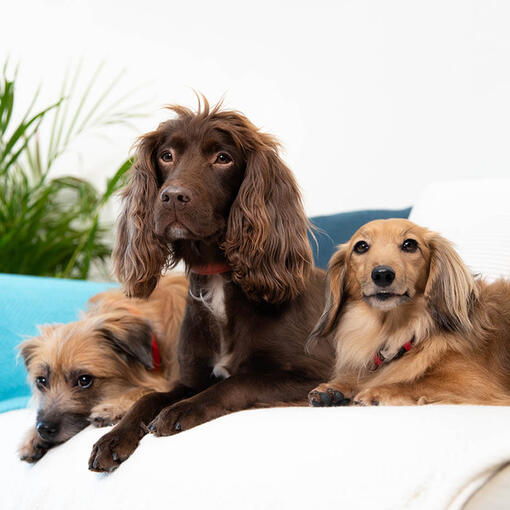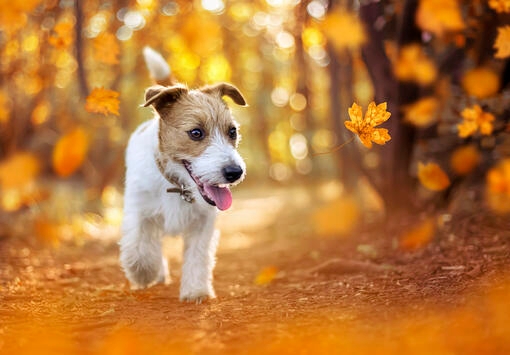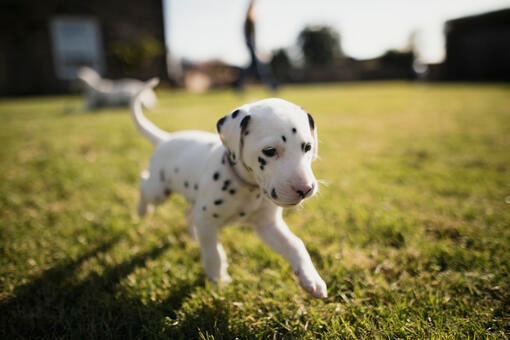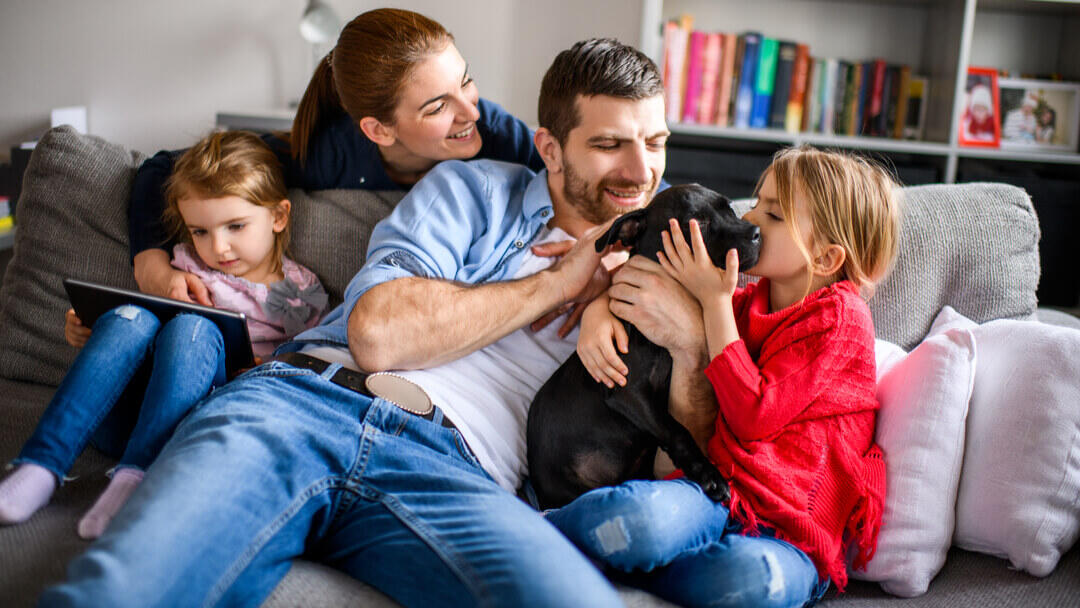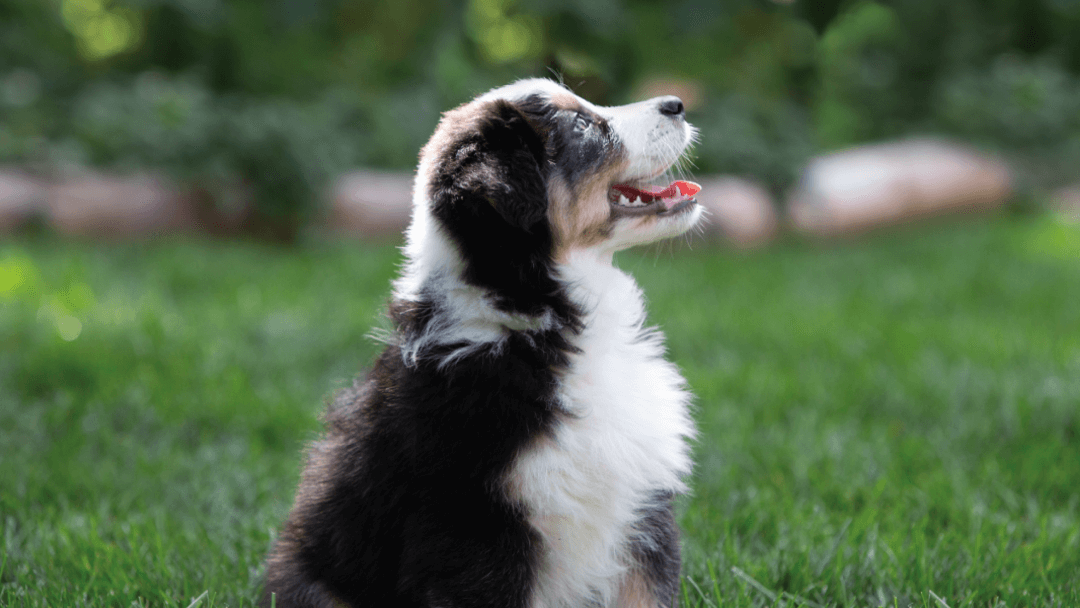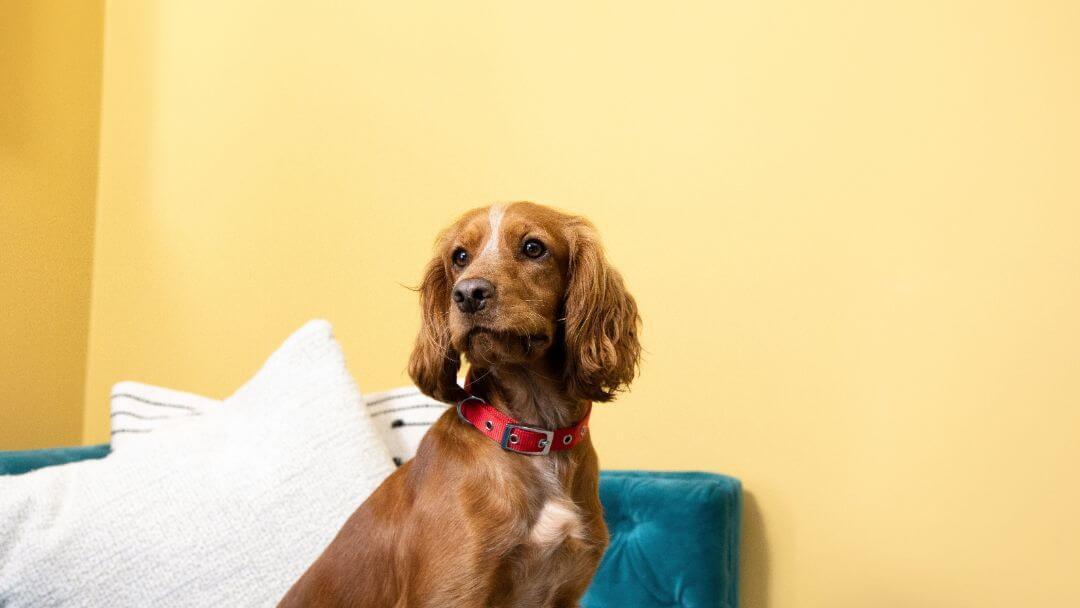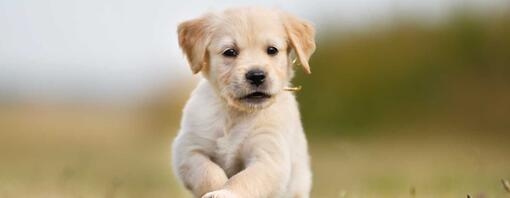
One of the reasons many dogs don’t get the exercise they need to stay happy and healthy is because owners are unable to let them off the lead. Actually, they can let them off the lead with no trouble at all, but it is when they need to catch them again that the problems start!
Why is recall training for puppies important?
Many behaviour problems can be lessened if a dog gets more appropriate exercise, and it certainly makes dogs easier to live with. Being able to let your dog off the lead safely means that they can have much more freedom – and the chance to explore, sniff and run in the great outdoors. More importantly, a good recall could one day save your dog’s life, as you can call them away from potential danger, so this may well be one of the most important life skills you can ever teach.
We’ve created an easy guide to puppy recall training in 6 easy steps.
How to start your puppy recall training
There is no point in only trying to call your dog back when you are already in the middle of the great outdoors, surrounded by other dogs, fabulous sniffs, plenty of tempting squirrels, and your dog has already vanished off into the distance. You are just setting your dog up to fail – and ruining what recall your dog might have.
Neither, as some owners seem to think, is getting a good recall automatic. It’s an exercise that needs to be trained and needs to be constantly reinforced with treats, praise and games throughout your dog’s life. This is an exercise that you have to start training at home from the very start of your lives together, long before you expect your dog to come back when you really need them to.
1. Very first steps – Watch me
Start by teaching a ‘Watch Me’ in the house – effectively teaching your dog their name, and also that you are a great person to pay attention to.
Teaching your dog to look at you when you want them to is the beginning of virtually everything else. It is a key part of training a reliable recall, and it is one of the best ways to ensure they are paying attention to you and ready to do whatever else you might want them to do.
Even more than this, dogs think about one thing at a time, and if you can teach them something simple that means that one thing is you, you are already half way to a well-trained dog – and you are far more likely to be able to distract them from anything they might be excited by, worried about or potentially reactive to.
2. Watch Me recap
For this you will need lots of tiny tasty treats that your puppy loves.
The cue for your dog to look at you is their name – and so you need to teach them that their name always means ‘good things for the dog’! Don't use their name for anything unpleasant, never call them to you for things they don’t like, and don’t use their name endlessly without meaning otherwise you are just teaching them to ignore it. From now on, their name is always going to be something they are going to look forward to hearing – and will associate it with getting nice things from you!
For the next few weeks, always have some dog treats in your pocket – and when you dog is not looking at you (but isn’t distracted with something interesting or asleep) say their name brightly and happily, and when they look at you, throw them a treat. Only say their name once – and if they don’t look at you, no treat! Move somewhere else and try again.
And that’s all there is to it - but do it in every room and at different times and start to do it when there are distractions around too! Do this for a week even if you think your dog can already do this without any problems! It’s always worth a refresh.
3. Moving towards you
Once your dog is reliable doing this, instead of throwing the treat, drop it on the floor. Start by dropping it/throwing it halfway between you and slowly you can build it up to dropping it at your feet.
Now your dog should be looking at you and moving towards you when they hear their name.
4. Add a cue word
Now you have the basis of a recall in place, you can add in a recall word to link that word to the action when they are coming towards you. This is where people often go wrong! Until your dog knows that the word (“here” or “come” – or whatever you want) means coming towards you, it is just a meaningless word. There is no point in adding it in when they aren’t coming towards you, as that will just teach them that “come” means don’t come – or come eventually!
Reward them with a treat when they get to you, so they always think coming to you is a great idea!
Practise this everywhere in the house and the garden – first of all with no distractions. There’s time to add these in later (as that is a far more advanced training exercise). As the distractions become greater, so must the value of the treats!
5. Practice recall training in different rooms – and then the garden
When doing this training outside, make sure you puppy-proof your garden with our guide to prevent any escaping pups.
Every time you work in a new location, start from the beginning again (with no cue word – and just dropping a treat) so you teach your dog that recall means come ‘wherever you are’. Dogs aren’t good at generalising and so they might know that “come” means “come in the kitchen” (or wherever it is that you train your dog in the house) but that doesn’t mean they know that “come” means “come in the garden” or “come in the park”. Remember this for the future and any time you are in a new place.
Once again, when you are sure your dog will come to you when you say the cue word (“come”, “here” or whatever you like), you can start practising it for real. Start slowly in the house, then in the garden (if you have one) – until they are reliably coming to you, on lead first and then off lead. Still long before you need it in the great outdoors.
6. Make it fun!
You can have fun with this too – and sometimes as your dog is coming towards you, run backwards away from them so they have to follow you. Or if you have the space, run and duck behind a tree or a bush. Always be excited and reward them when they ‘find’ you. Make it a game that you can both enjoy. So often people only call their dogs at the end of a walk and so teach them that “come” means ‘the fun is going to stop now’ – so no wonder they are not rushing back!
First steps to puppy recall training outdoors
Now you have got a good reliable recall at home and in the garden, you are ready to get out and about and practise your recall ‘for real’.
Safety is the most important thing – so start off in a place with few distractions and have your dog on a harness and a lead. Use either a 2m training lead or better still, a long line.
Start from the beginning again and do some ‘Watch Me’s’ by dropping a treat close to your feet.
Then start to practise recalls. The lead/long line will mean your dog can’t go too far away from you (most dogs have a crucial distance beyond which they become ‘selectively deaf’!) – and while you shouldn’t be reeling them in with the lead, it does mean you have the security of knowing they are safe – and if you need to, you can begin to guide them towards you as a last resort.
Once you are confident your dog will come back when you call them, you can begin to practise off-lead as long as you are in a safe and secure location.
The great outdoors can be really distracting so always reward recalls with a high value treat you know your dog loves.
Make puppy recall a game. Do lots of chase games, hide and seek and have fun with recall training. By making it a game, it becomes even more rewarding for you and your dog. Training shouldn’t be boring!
Top tips for puppy recall training
Now that you know how to start teaching your puppy to come back when you call them, you now just need to practise but here are some helpful Top Tips. Read on!
1. Get everyone involved
If you have someone who can help you, you can get them involved to hold your dog while you take a few steps away and then call them to you. This means you can get greater distance while still keeping your dog on a lead. They can do this with a training lead or the long line. The whole family can get involved with doing this – and it helps everyone understand recall training.
You can make this a great fun family game that further reinforces your dog’s recall, and gradually build up the distance even further.
2. Catching your dog!
The whole point of recall is that you can call your dog back to you – and if necessary, be able to put them back on the lead. Some dogs can get really good at whizzing back to you, grabbing a treat in the passing, and whizzing off again! Others don’t like being caught as they have learnt that it can be uncomfortable if someone grabs hold of their harness or collar and so would far rather avoid that.
In other cases, your natural body language will be telling your dog something very different from what your voice is saying – and dogs rely far more on your body language than on your words.
When you are calling your dog, never lean forward (in dog body language, this can be seen as threatening and says ‘go away’!)– and don’t grab them when they get to you. Both of these things will inhibit your dog and make your recall less reliable.
Instead open your arms and almost lean back. If you have a puppy or a small dog, crouch down so you are not looming over them. When they get to you either drop a treat on the ground or give it to your puppy from your hand. Only then – when they are enjoying a yummy treat, can you quietly slip your finger into the collar or the harness. Hold them for a few seconds – or even clip the lead back on – then let them go off again.
Make sure the lead you are using has an easy to clip on fastening, so you don’t have to pull or wrestle with the harness or collar – and that it is quiet. This is going to be close to your dog’s ears and sometimes this potentially sharp noise can be worrying.
This is something to practise at home first – and even practise clipping the lead on smoothly and quietly without the harness or collar being on your dog.
3. Play puppy recall games
As you did in the house and, play recall games to make coming to you even more fun and even more rewarding.
There are lots of recall games you can play with your dog – calling them between family members (which can be great fun if you have children) or playing chase games where you run away from your dog excitedly, calling them as you go, and then stopping and rewarding them when they get to you (not to be done with children as it can all get too exciting and there’s a danger of bouncing and grabbing!).
For dogs who love toys and games, reward them with play session (like a tuggy game) when they come back to you as well as a treat.
Next steps in puppy recall training – making it real
Now you can begin to practise every single time you are out with your dog. Always try to set your dog up for success, so at the beginning of your training (and especially during adolescence) only call them back when you are fairly sure they will come to you (so not while they are totally engrossed in something) and if you are not confident in either your dog or the new environment/distractions, keep them on a lead/long line. It is important that they don’t think of recall as being a multiple-choice question!
If you follow these steps, you will soon have a dog who you can let off the lead to get all the exercise and free-running they need to stay happy and healthy.
Do’s and don'ts for teaching puppy recall
Do’s for puppy recall training
- Once in the ‘real world’ or in a new environment, start slowly in a quiet enclosed place with no distractions.
- Do a few on-lead recalls first before doing anything off lead – and if you are confident using a long line without tying your legs together, this will be very useful as you can get more distance safely!
- Give them a treat immediately you let them off lead. This will stop them excitedly vanishing off into the distance and instead paying attention to you from the moment you let them off lead – and it will remind them that you have fabulous treats! (and, for this you do need fabulous dog treats – something your dog loves above everything else).
- Call them back frequently for games and rewards – not just when you want to put them back on the lead and take them home.
- Keep them focused on you with play and games– and always reward good recalls.
Don’ts when recall training puppies
- Don’t let them wander too far from you (all dogs have a crucial distance beyond which you have far less influence!).
- Don’t just recall your dog at the end of the walk.
- Never stop practising – and go back a few steps (even repeating all of this again) if your dog’s recall starts to slip. It is natural for this to happen as your puppy goes through adolescence (in fact you might well find they need to be on a long line for a lot of this time – especially when there are a lot of distractions. Far better than this is that they learn that they can easily ignore you (or more likely in adolescence, don’t even hear you!).
- Never stop rewarding good recalls – it could one day save your dog’s life.
- Don’t be boring!
Remember there are some dog breeds or individuals who may never have a reliable recall no matter how hard you work at it (often sight hounds fall into this category). For them do the best you can to make your recall as good as it possibly can be (and it can still be perfect where there are no distractions so don’t use breed/type as an excuse not to train!) but then be prepared to recognise and accept their limitations (don’t rely on your recall for safety) - and find ways to exercise them and let them run in safe, enclosed spaces.
Like all your training, teaching your dog to come back when you call them should be fun – and it will allow you both to enjoy your walks far more and get more exercise. It will also be the basis for any dog sports you might want to try your hand – the vast majority of which are done off-lead.
NOTE: Never let your dog off lead anywhere that is unsafe, near traffic or livestock, or if you don’t know they will come back to you.
We hope this guide to puppy recall training was helpful! Next, make sure to take a look at our dog training guide for more information on how to train your pup!

